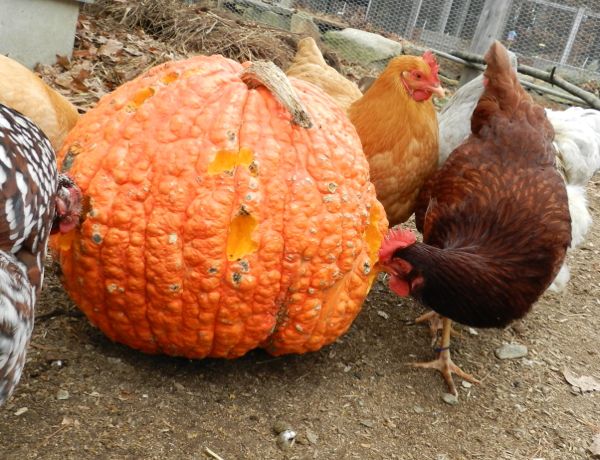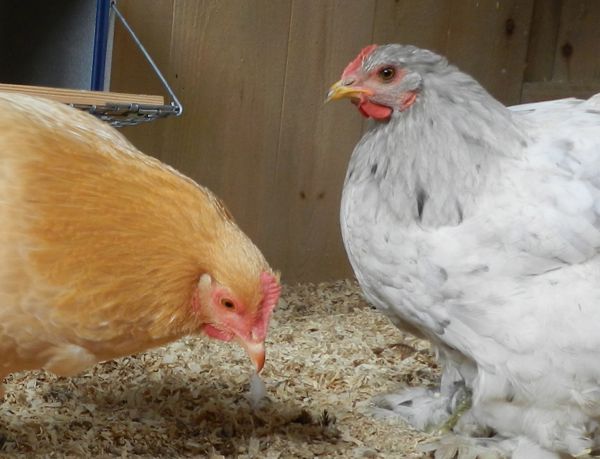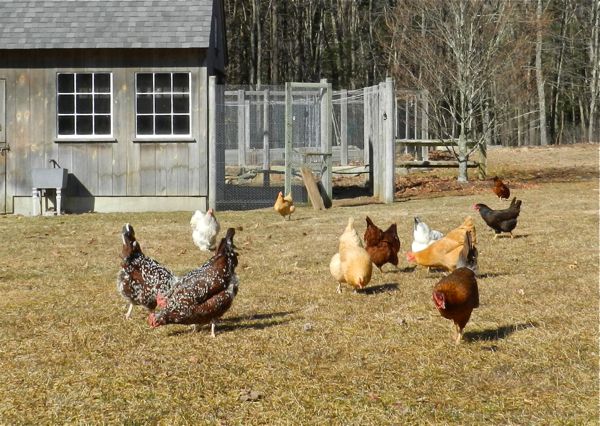Everyone has heard of the term pecking order, and we all knew, when starting out, that our own flocks will be party to that most basic of chicken behaviors. Still, the beginning chicken keeper is often taken aback at what goes on. Chest thumping, feather pulling, blood letting! It’s not pretty and it doesn’t look nice. In the worst case scenario, a picked on hen will be killed by the others. This happens. Some people ascribe all sorts of bad intentions to the offending “bullies” but in truth the animals are not at fault, for their behavior is due to how we manage their care. It’s up to us to control the flock dynamics to have the best scenario, that of a peaceful, healthy flock where everyone lives amicably together.
All flocks have a pecking order, and as the term implies, it is established by using their beaks. But, that does not mean that the hens spend their days attacking each other. A group of chickens should quickly reach an agreement, and each hen will know her status. Status determines who gets the best tidbit and who gets to sleep in the prime spot on the roosts. Despite the fact that chickens have no qualms about bossing underlings around, once the pecking order is set the flock should be peaceful with no obvious bullying, and certainly no terrorizing the low status birds into corners or drawing blood!
Chicks that grow up together rarely have issues. They’ve figured out who’s on top from early on. As the pullets mature there might be a few spiffs as a hen gets larger and bolder, but there shouldn’t be anything dramatic or bloody. Because, as much as it’s called “pecking order” the hens have all sorts of body language that they use before they have to resort to stabbing each other with their pointy beaks, and the low-status birds are smart enough to get out of the way.
If you have a flock of hens that know each other well (no new girls coming in) then all should be peaceful. If there are frequent squabbles, or if a hen is getting bloodied, then you have a management issue.
The most common reason for pecking order violence is crowding. Each hen needs a minimum of 4 square feet of floor space inside and another 8 outside. Be aware that there are times when the chickens won’t be spread out evenly. Take a look at your hens’ accomodations during inclement weather. Are they crammed together? If your hens are attacking each other, but have space, then reorganizing the coop can sometimes relieve the pressure. Adding outside roosts can give the lower status hens a place to go, or conversely, a perch from which the high-status hens can survey their realm. It doesn’t matter which, what matters is that the hens can move freely away from each other and have their own places. Chickens are greedy and possessive about food. Hang the feeder so that the hens can circle around it and no one gets trapped in a corner when trying to eat. Add a second waterer outside. When providing treats, set them out in several places.
Chickens get bored, and hens kept in small dirt pens will get in trouble. That’s why I don’t give treats like corn that they quickly gobble up, but instead provide a compost in the run so that they have an interesting place to scratch for hours. That’s also why I give them pumpkins in the fall,

hang a cabbage in the run when they’re closed up due to snow,
and why I’ll toss them clods of dirt and weeds in the summer.
It’s rare (it’s only happened once here in 16 years) that you’ll have a hen who is a bully and despite having everything that she needs, goes after the other hens with an unrelenting viciousness. Remove her from the flock for four days. Put her out of sight. When she is returned she will be at the bottom of the pecking order and she will rarely go back to her aggressive ways. If she does, get rid of her.
There are times when the pecking order gets upset. If a hen becomes ill the others will go after her. Chickens recognize each other by their combs, and a change in it’s color (which can happen at the onset of illness before you notice something is wrong) will set them off. If all of a sudden your flock dynamic has changed, take a look at your hens’ health! If a chicken does become wounded, the red blood will make her a target of the entire flock. If it’s not severe, darken the exposed skin with blu-kote (a purple antiseptic), if it’s open and bloody, remove her from the group until healed.
Pecking order is always disturbed when new chickens are introduced. Even if you have only one hen, and think to add a second as a friend you’ll have aggression – just because you like that new chicken doesn’t mean that your hen will immediately bond with her. During a normal bit of sorting out there will be chest thumping and running at each other. This can go on for days, but things should quiet down. It can be especially difficult adding one young pullet to a flock of hens. I have tips on how to merge new hens into an established flock here. Sometimes the attacks seem endless and they can be severe. I’ve seen a hen jump on another’s back to pin her down and fiercely peck at the head. Chickens doing that can kill. Roosters don’t allow this sort of hen on hen attack, and stop it by interrupting the behavior. This is something that you can do, too. Sometimes all it takes is for you to pick up the bully and move her away from the hen that she is focused on. Do this a half-dozen times and she usually gets the message. Don’t you become violent and swat or hit the offending hen. That won’t effectively communicate to her that she needs to cease her attacks. If you aren’t able to stop the bullying, then remove her from the group for a couple of days while the new hens settle in.
A flock of hens that all get along is a pleasure to have in the backyard. However, underneath their cheerful clucking, the pecking order is always simmering. If you pay attention to your hens’ behavior, health and resources, it won’t boil over, and you’ll all be happy.




Terry, I enjoy all your suggestions about keeping chickens, especially this one on pecking order. Once, one of our bantam hens hatched a clutch of mostly roosters. The majority of them attacked the smallest one which had a limp.
We put Mercurochrome (orange-red, didn’t know to use blue violet). We had to raise him in a separate pen.
Love all the photos, especially the audio of the hens cackling so loud.
Is the largest hen usually the head honcho? Or does that really matter? I have my first flock (5 & 1/2 months old) and they just started laying. 2 Barred Rocks, 2 orpingtons and 1 Wyandotte. One of the rocks is at least 1.5lbs heavier than all the rest, and she is the leader. She’s a sweet kind benevolent leader, but she will kick some tooshie if she has to to prove herself. I was just wondering if there are ever small hens that lead with attitude rather than sheer bulk?
It’s personality, not size that matters. In her day, my first bantam White Leghorn, ruled the coop! Opal is the largest hen of the Gems and she’s at the bottom of the pecking order. I bet you’ll find your Rocks on top. They tend to be active foragers and don’t like crowding.
So even Pearl will boss Opal around, that must be funny to see. I have heard that hens will also go broody to increase their status in a flock as well. Have you seen that with your crazy broody Beryl and Pearl, have either of them increased their status in the flock maybe with Pearl from being one of bottom hens to the middle ?
Opal is the largest hen in the younger hen group and she isn’t the boss. I think it’s one of the Rhode Island Reds. I think yes, size does matter, but not always I have heard of a more than one bantam hen ending up being the ruler of a flock even over larger hens. I think it’s health, age, breed, and aggressiveness when it comes to who ends up being flock leader, and maybe even smartness. And I have seen a good head hen of a flock even raise a single chick this summer in the midst of her flock.
No, I don’t think they’ll go broody to increase status. In fact, top hens lose status and get pecked at when they go broody.
One of my rocks, Iggy is the Top of the heap…. the other Rock, Ma Sanders, is on bottom. She’s just a dumb as a brick, but she’s put an egg out every day since 4 & 1/2 months. She’s sweet and very talkative. If she hears me talking in the house she’ll run to get a close as she can and she’ll start jabbering…. When she sees my daughter she runs up to her and squats down so she’ll pick her up…. Funny girl!
Tell me you named her for Col. Sanders wife?!
You know it! LOL Originally it was Mrs Sanders, then it evolved to Ma Sanders, now we just call her “Big Ma”
Terry your spot on about the rooster. My Murray when he sees two hens squabbling will run over, then slowly walk between them. The hens then go about their business, well 99% of the time anyway. Occasionally, I am assuming he is reading body language, he will flog one of the hens and then that brings an end to it.
Ken, I know you have had hens such as your Whichaway and Wrongaway live for a long time ? Have you ever just had a good rooster that you kept even into retirement that lived as long too maybe in a pen with your older pet flock ?
I’ve noticed that there arent as many nesting boxes as you have hens. Dont the hens like to have their own box?
For fewer than 5 hens you need only two or three boxes. After that, just 1 box for 5 hens. They lay at different times AND they all like to crowd into one box!
A long time ago I had a little red hen who managed to break her leg. I was a young teen at the time, and instead of putting her down, I set and splinted the leg. My Dad helped. We used an old wire hanger to splint it. Anyway, she survived, but had a pronounced limp and had been out of circulation with the rest of a large flock for 4 weeks. When I added her back in, I stayed with her just in case they ganged up on her. I need not have worried. 4 hens rushed her at once and she beat the living daylights out of all of them. I guess she was top bird before the broken leg, and she wasn’t about to go in as the underdog.
Yep, it’s all about attitude.
One thing I’ve noticed is that hens rescued from intensive farming (cages or barns) always end up at the top of the pecking order … probably because they have had to fight for their survival all their lives. I’m about to add four new rescue hens to an established brood of six … and to be honest, I’m dreading it! It’s already obvious that the bottom hen of the four new girls is quite happy to square up to the top hen of the established girls …
It’s also in the genetics. Now that the factory producers have to have hens milling together and not in cages, they’re finding that the egg production trait has been lined to aggressiveness (roosters, too.) They’re now trying to breed for docility. I’ve read some interesting reports in the trade media about this. Check my FAQ page for a FAQ about introducing new hens to an established flock – you’re experienced at this buy maybe there’s a hint there that can help with the transition.
I have 6 hybrid layers, an Australorp and recently bought three bantams. I am surprised that one of the bantams, a White Leghorn, wants to peck the hybrids through the fencing of their run while she is free ranging, she’s a bold one!
Who is the top of the pecking order out of your lot?
We all need space for sure! (I had company for a few weeks and by the end of their visit I really appreciated that sentiment.) We enlarged our flock this spring by adding sixteen pullets to our existing flock of nineteen hens and one rooster. We got the new ones as chicks and added them to the flock after about six weeks, breaking the rule that says do not introduce pullets to older hens until they are five months old due to potential disease issues and reducing the chance the pullets, much smaller than the full grown hens, will get picked on. However, we have done this successfully before, integrating young birds with older ones, for a couple of reasons: enough space, including a separate area for the new ones to roost, and enough new ones to create their own flock, at least at first. The hens attempt to peck the pullets but the younger pullets are more nimble and easily get away. Importantly, there’s room for them to get away and we have a number of separate feeding and watering stations. (We have fifteen nest boxes but of course they prefer four or five choice boxes!) At night, though they are all housed in the same structure, they have separate rooms to roost in. After a few months some of the new ones will move into the older hens’ roosting area and vice versa. Of course we keep an eye on things but so far, so good each time we’ve done this.
Sounds like a sensible system to me!
I have been fascinated by the whole pecking order thing since I got my first chicks 2 years ago. My first flock of 6 had my smallest, most different hen (bantam frizzle cochin) at the waaaaaay bottom. She was so badly pecked I gave her away. Currently my smallest hen, a Dominique, is headmistress. This year I got 4 new chicks to add to my 4 older hens, figuring equal numbers might be protective during the integration process. What I noticed is what you said: there isn’t much jockeying in position with a flock raised together. Adding more chickens is what creates stress. In situations like mine, where I am limited by law to only a few hens, there is really no way to practice the ‘all in, all out’ system. I am already over the limit allowed in my town (4 ‘poultry’ units) with my (ahem) 7 hens.
Currently I have 2 hens from my original 2010 flock, 2 more added in 2011, and 3 new pullets from this year. What I notice is that yes, there is an overall pecking order, with Maisie on top and the new kids at the bottom. But the hens prefer to associate with their original flockmates, so they hang out in 2, 2 and 3. I wish I had the space and the legal leeway to just have 2 separate coops, so I could keep each new year’s kids together for minimal integrative stress.
I may yet see my way to creating a second coop. I have a large (1/3 acre) corner lot, with a big backyard and lots of open space between my yard and all the neighbors. I have a couple of other fantasies still to manifest, including bees. A friend knows someone who captures wild swarms and gifts them to people who are interested in ‘adopting’ them. He even provides the bee boxes. My friend has two separate hives, one in a regular box and the other in the original hollow tree where the bees were found. The bee guy closed up the holes, sawed the tree in half, transported it to my friend’s house and reassembled it.
Have you ever had bees, Terry?
Anyway, I enjoy hearing tales of pecking order from everyone. And I appreciate being in a position to associate with my chickens and learn about the natural order of things.
I have not kept bees in a hive, but my yard is full of bees on the clover and flowers. I have poultry books from the 1920s with some very clever “village hennery” coops. One has two pop-doors, on either end, and the whole front is windows. It can be divided in half for two flocks, or used for one. Two runs can be contracted side by side.
Well, I am once again surprised about how much I didn’t know about chicken keeping when I started this journey. I purchased 8 chicks of which four died the first night we had them. I added three pullets several weeks later and the older ones quickly became the boss chicks. Then, I decided I just had to have 6 more when the local farm supply he a new shipment. Now I have two separate flocks! Not sure if they will get along but I guess that’s ok as long as it doesn’t get bloody